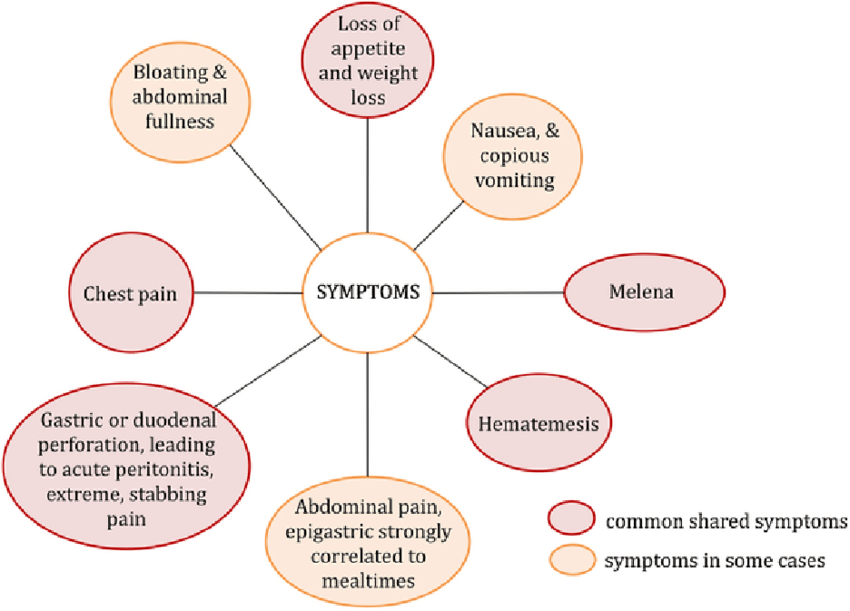
Ulcers can manifest in various forms, affecting different parts of the body. Understanding the symptoms associated with peptic, mouth, and skin ulcers is essential for timely diagnosis and effective treatment. In this blog, we will delve into the detailed symptoms of each type of ulcer, highlight the differences between them, and emphasize the importance of seeking medical attention when needed.
Detailed Symptoms of Ulcers
1. Peptic Ulcers
Peptic ulcers are open sores that develop on the lining of the stomach or the first part of the small intestine (duodenum). The primary symptoms include:
- Abdominal Pain: A burning or gnawing sensation in the stomach area, often occurring between meals or during the night. The pain may temporarily subside after eating but can return.
- Bloating: A feeling of fullness or swelling in the abdomen after meals.
- Nausea: A sense of unease or discomfort that may lead to vomiting.
- Loss of Appetite: Reduced desire to eat due to pain or discomfort associated with food intake.
- Heartburn: A burning sensation in the chest due to acid reflux.
- Weight Loss: Unintentional weight loss may occur due to decreased appetite or avoidance of food to prevent pain.
- Dark Stools: Black, tarry stools may indicate internal bleeding, which requires immediate medical attention.
2. Mouth Ulcers
Mouth ulcers, also known as canker sores, are small, painful lesions that develop in the oral cavity. Symptoms include:
- Painful Sores: Small, round, or oval sores that are white or gray in color with a red halo, typically located on the inner cheeks, gums, or tongue.
- Sensitivity: Increased sensitivity to spicy, acidic, or salty foods, which can exacerbate discomfort.
- Difficulty Eating and Speaking: Pain can make it challenging to consume food or speak comfortably.
- Swelling: Surrounding tissues may become inflamed and tender.
3. Skin Ulcers
Skin ulcers, or pressure ulcers, can develop due to prolonged pressure on the skin, often in individuals with limited mobility. Symptoms may include:
- Open Sores: Red, painful areas that may develop into open wounds on the skin, typically over bony areas such as heels, elbows, or the tailbone.
- Discoloration: The skin around the ulcer may appear red, dark, or purple.
- Swelling and Warmth: The area may be swollen and warm to the touch, indicating inflammation.
- Foul Smell: Infected ulcers may emit an unpleasant odor, which could signal a need for medical evaluation.
Differences in Symptoms for Each Type
While the symptoms of ulcers can overlap, certain characteristics distinguish them:
- Location: Peptic ulcers occur in the stomach and small intestine, mouth ulcers in the oral cavity, and skin ulcers on the surface of the skin.
- Type of Pain: Peptic ulcers often present as deep, gnawing abdominal pain, while mouth ulcers cause localized sharp pain when eating or speaking. Skin ulcers may have a throbbing or aching sensation, particularly if infected.
- Additional Symptoms: Peptic ulcers can lead to digestive symptoms like bloating and dark stools, whereas mouth ulcers primarily affect oral function and comfort. Skin ulcers may include signs of infection, such as warmth and foul odor, which are not typical of the other types.
Importance of Timely Diagnosis
Recognizing ulcer symptoms early is crucial for several reasons:
- Prevention of Complications: Early diagnosis can help prevent complications such as bleeding, perforation, and infection, particularly in peptic and skin ulcers.
- Effective Treatment: Identifying the type and cause of the ulcer allows for appropriate treatment strategies, leading to faster recovery.
- Improved Quality of Life: Addressing symptoms promptly can enhance overall comfort and well-being, allowing individuals to resume normal activities and avoid unnecessary suffering.
When to Seek Medical Attention
It is essential to seek medical attention if you experience any of the following:
- Severe or Persistent Pain: If abdominal pain is severe, persistent, or worsening over time.
- Signs of Bleeding: Dark or black stools, vomiting blood, or noticing blood in saliva or mouth ulcers.
- Signs of Infection: Redness, swelling, warmth, or foul odor associated with skin ulcers, or fever accompanying mouth or peptic ulcers.
- Difficulty Eating or Drinking: If mouth ulcers make it challenging to eat or drink, leading to dehydration or weight loss.
- Unexplained Weight Loss: Significant weight loss without trying or an ongoing loss of appetite.
Conclusion
Understanding the symptoms of peptic, mouth, and skin ulcers is vital for timely diagnosis and treatment. Each type of ulcer presents unique symptoms, and recognizing these differences can aid in seeking appropriate medical care. If you experience any concerning symptoms, don’t hesitate to consult a healthcare professional. Early intervention can lead to effective treatment and prevent complications, helping you regain your health and well-being.

